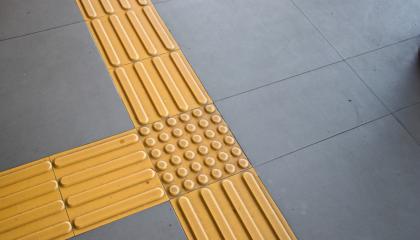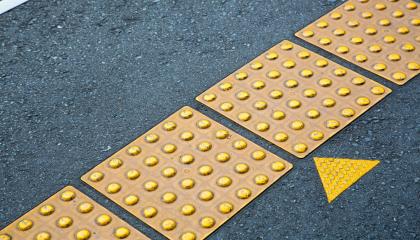Over the last few years, more and more urban designers and architects are incorporating radius shapes as part of their exterior designs. These new shapes bring modern life to an intersection rather than the classic rectangular ramp pattern we are all accustomed to. These specific radius tiles are made-to-order and manufactured with the same nano-engineered polymer concrete material as the standard TekWay ADA Dome Tiles to ensure long lasting durability and functionality.
Truncated domes or detectable warning tiles are designed to withstand sustained pedestrian traffic, and in order for them to remain reliable over the span of many years, a minimum compression strength of 12K psi is recommended. From severe weather conditions to heavy commuter traffic, detectable warning dome tiles must be ready to withstand the ambient conditions that will consistently test the integrity of the structure.
The Americans with Disabilities Act provides a guideline for how companies and public spaces can be made accessible for individuals with disabilities. While most of the standards focus on building design and public area accessibility, the ADA offers information on the best practices for ADA compliant flooring. When planning your flooring project, consider the specifications for floor and ground, including surface characteristics and carpeting.
Sidewalk cracks are often an accepted reality of city living, however, non-ADA-compliant and broken sidewalks often result in injury for pedestrians, unnavigable sidewalks for people with mobility devices, and lawsuits against the city.
It’s not unusual to find missing pavement, crumbling curbs, and weeds sprouting between cracks. However, for people who use wheelchairs, broken sidewalks can be impossible to navigate, forcing them to stay at home or use the road to get around. So a simple crack in a sidewalk is not so simple and potentially dangerous.
How detectable warning tiles are installed is crucial to the longevity of the project. There are two types of installations that you need to know about: wet-set and thin-set. Both the wet-set and thin-set installation methods can be used on new construction as well as upgrading pre-existing ramps. Each type of installation can provide longevity and durability when installed correctly.
When the United States passed the Air Carrier Access Act (ACAA), it became illegal for airlines to discriminate against passengers who had an impairment. The law applies to any airline that provides air transportation to, from, or within the United States. Not only does this law cut down on discrimination, but it also requires airlines to provide assistance for passengers, such as a wheelchair, guided assistance for all areas of boarding, or seating accommodation.
Cities and businesses are scrutinizing pedestrian walkways to determine how to best increase the ADA compliance of public spaces. ADA compliant sidewalks make businesses and public areas more accessible to individuals with disabilities. A key component of an ADA compliant sidewalk is the truncated dome tiles that warn pedestrians of a change in the sidewalk, whether an intersection or a ramp.
These truncated dome tiles have two common ways of being installed: cast-in-place or surface-applied.
Connect with us
We pride ourselves on our customer service, and we'd love to hear from you! Sign up for our newsletter to keep up with industry updates and trends, as well as any new product releases.









